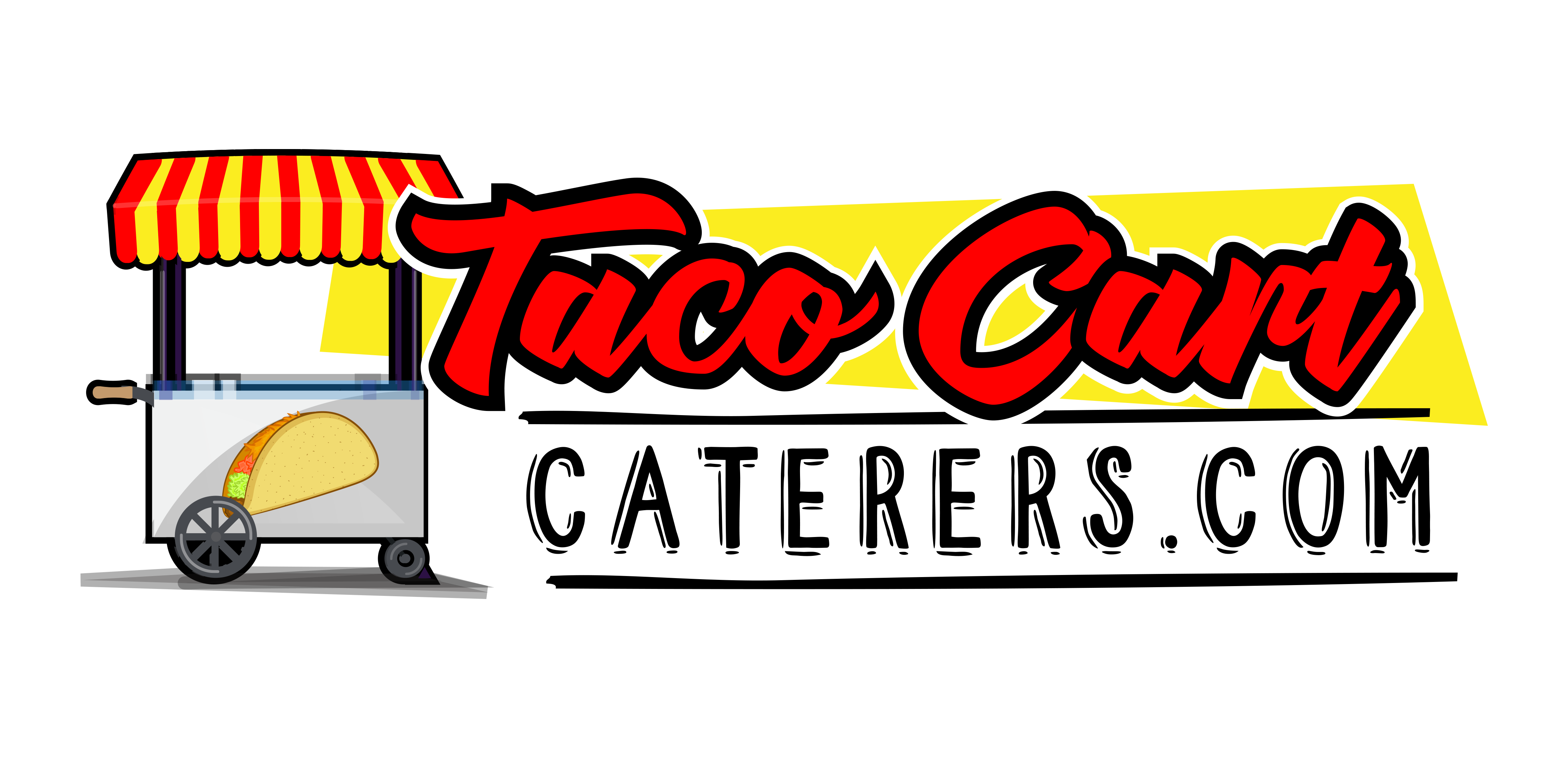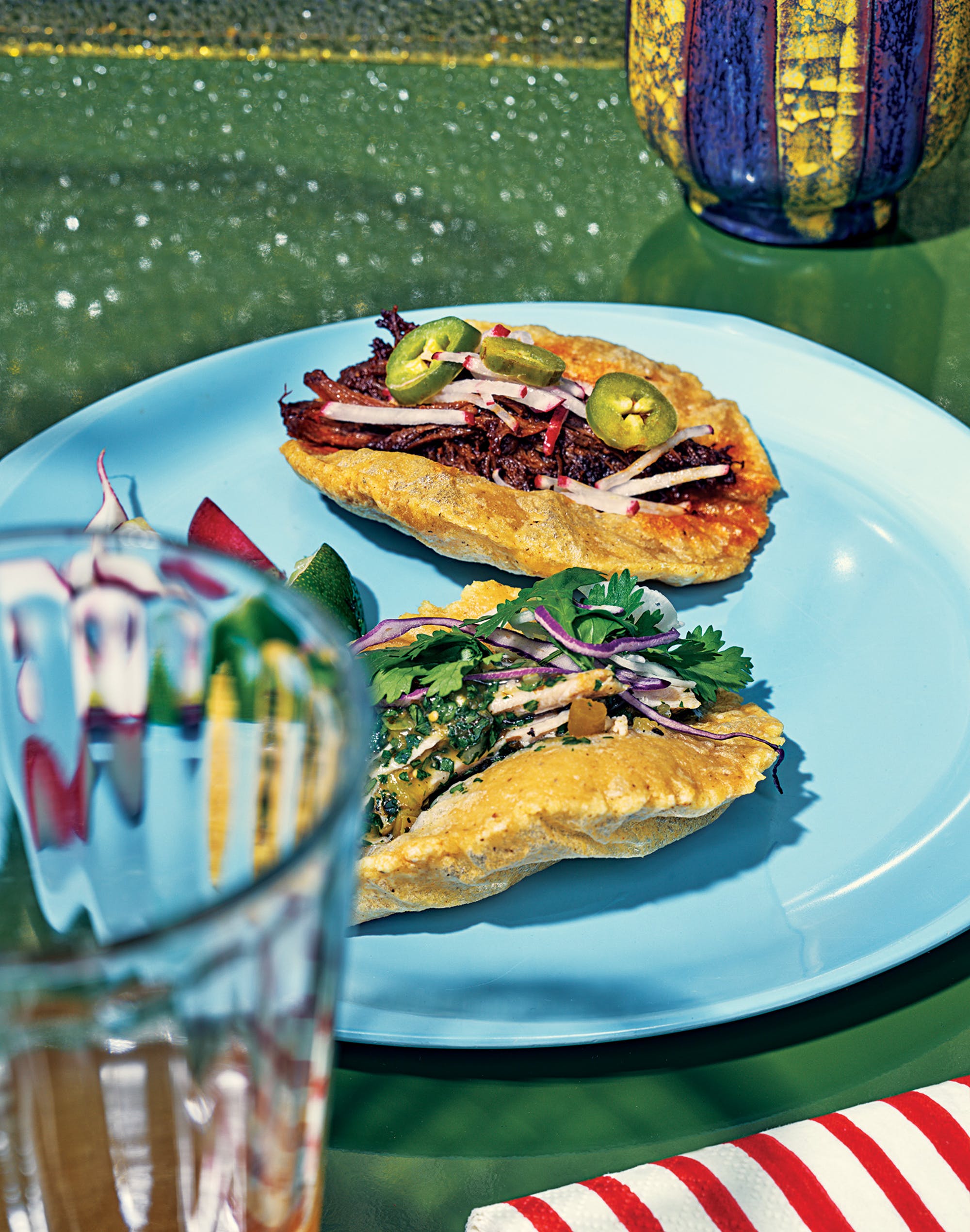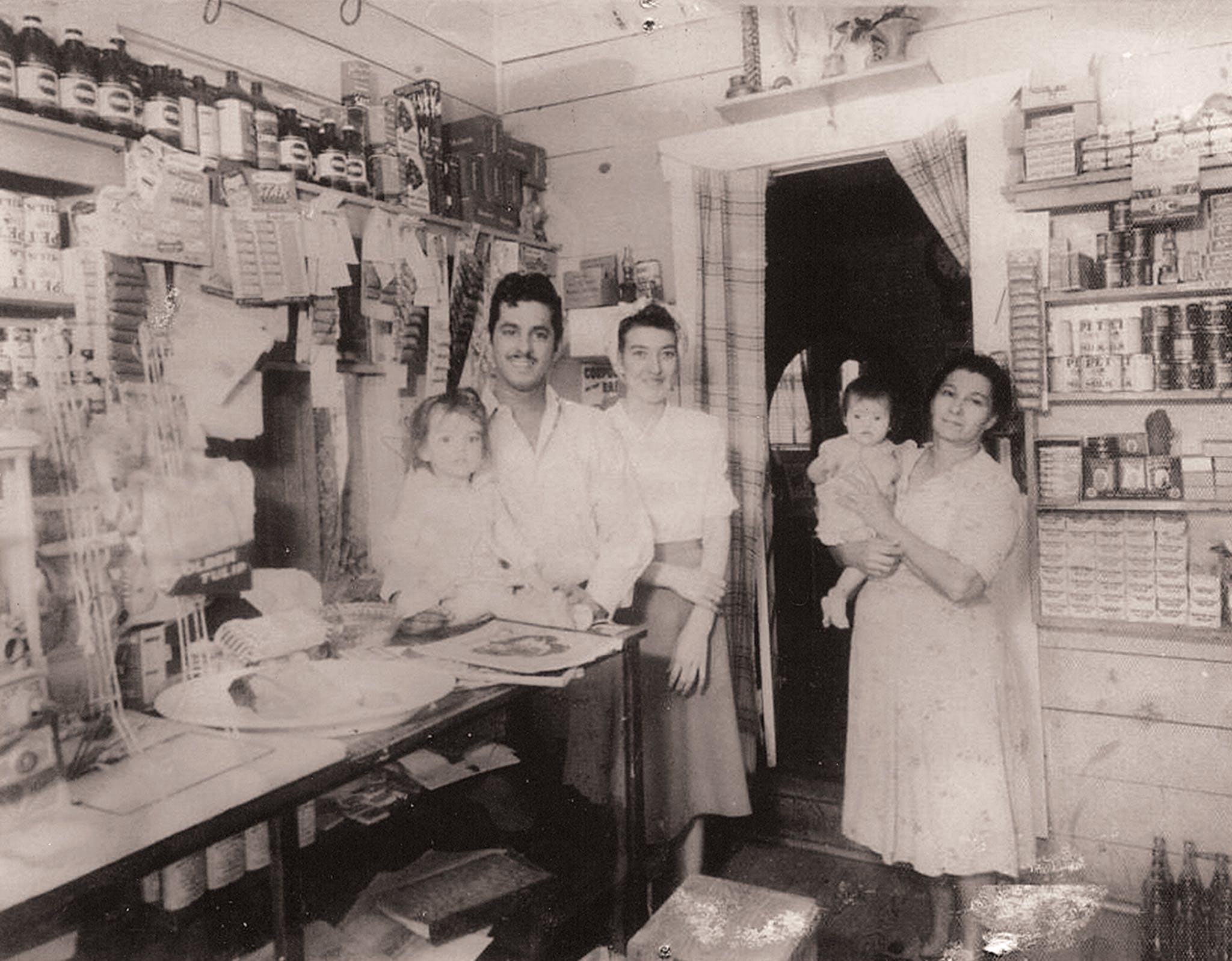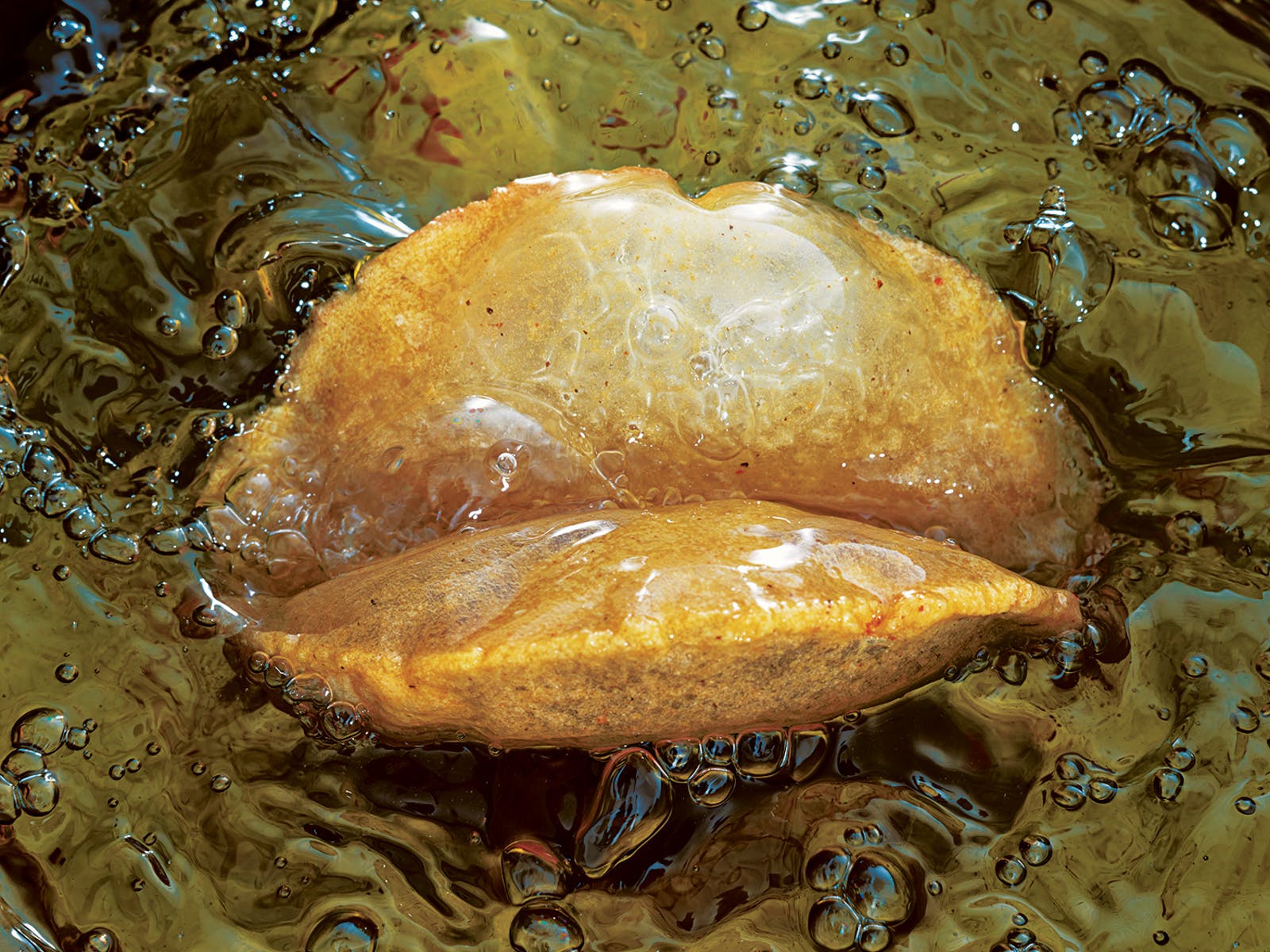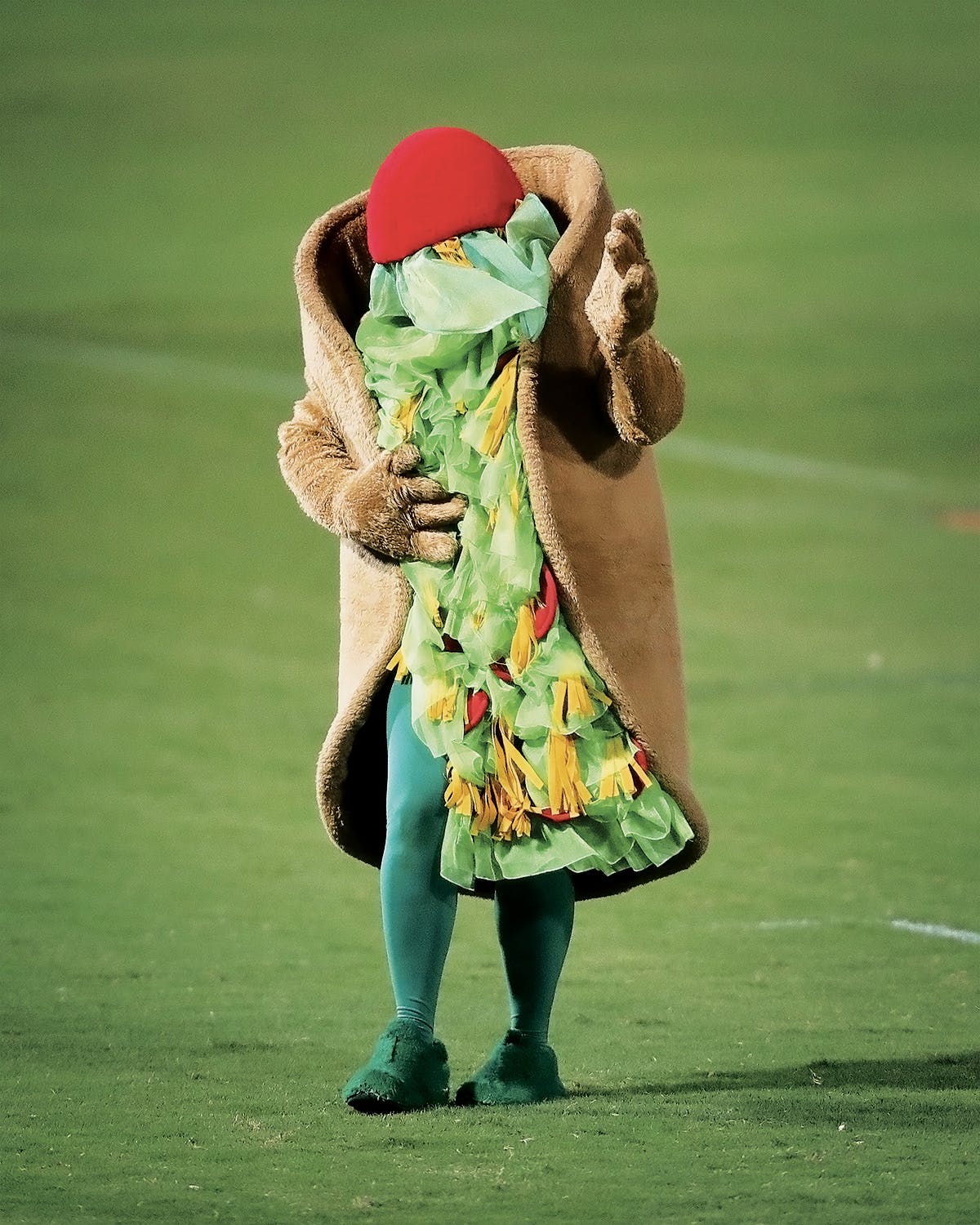The cumulus-light treasure can be found all over the Alamo City, in food trucks and beloved restaurants, including, quite famously, a repurposed Dairy Queen. The puffy taco is a source of pride among locals, and there’s no other place in Texas—or, perhaps it goes without saying, the world—where you can find them so easily. And certainly no other baseball team in the world has a Henry the Puffy Taco, who proudly and ably represents the minor league San Antonio Missions as its unofficial mascot.
But is San Antonio the home of the puffy taco in a more profound sense—is it the puffy taco’s place of origin? Many locals certainly think so, though there’s some dispute over the answer. As is the case with many Tex-Mex staples, numerous Mexican Americans and Tejanos insist that a long-gone abuelita invented the puffy taco at her modest kitchen stove. We can take virtually all of those claims with a grain of salt, but that “virtually” carries a lot of weight; San Antonio does have a First Family of Puffy Tacos, and according to them, it was indeed a sainted grandmother who invented the puffy taco. We’ll get to that story in a moment.
First, let’s explain, for the uninitiated, what a puffy taco is, and what sort of lineage it draws on.
The puffy taco is similar to the salbute, a lightly fried tortilla with Mayan influences that is served flat (unlike a puffy taco, which is crimped in the center). The salbute, a specialty of the Yucatán Peninsula, is topped with a small serving of meat, usually chicken or turkey, and garnished with pickled red onions, tomatoes, cabbage, and salsa.
The puffy taco also resembles the gordita inflada (“inflated fatty”), a puffed, bubble-like tortilla that can be stuffed with sweet or savory fillings and is usually found in Veracruz, though it is increasingly found elsewhere, including the United States. My favorite gordita inflada is the version sold at Mexico City’s Restaurante El Bajío, a legendary establishment specializing in traditional Mexican regional cuisines. Raúl Ramírez Degollado helped open the first location, in 1972, in the city’s Azcapotzalco neighborhood, and today the restaurant has nineteen outlets across the city, which were all overseen by his widow, Carmen “Titita” Ramírez Degollado, until she retired recently and her son Raúl took over. El Bajío’s gorditas infladas are blue-corn tortillas, punctuated by anise, that have been fried on a comal until they inflate, and are served with a thick salsa flavored with chile chipotle meco (a burnt chile) and piloncillo (unrefined cane sugar).
The San Antonio–style puffy taco is a mercurial nosh that begins, like the salbute and inflada, with a ball of raw masa flattened into a disc. The dough is pressed into a tortilla form and then deep-fried until the disc begins to bloat and crisp, and, at just the right moment, is crimped with a spatula or similar utensil into the familiar U-shape of a taco shell.
During this process, the corn disc must be given the cook’s full attention. The interior of the glistening delight should be soft and chewy. The outer layer should be snappy and flaky. It should be light, not greasy, and keep its structural integrity long enough to be filled with ground beef or shredded chicken, maybe some avocado, topped with tomatoes and lettuce, and shuttled to a table. It should be consumed as quickly as possible, before the contrasting textures of the taco work in opposition and degrade the dish. Left untouched for a few minutes, the taco’s bottom will become soggy and separate from the two sides, leading to a meaty mush and a shattered shell. These are fleeting creations intended as immediate sustenance.
According to Maria Lopez-Rambo, co-owner of San Antonio institution Ray’s Drive Inn, there’s no great mystery about the origin of the puffy taco: it was invented sometime in the early twentieth century—the exact year is lost to family lore—by her paternal great-grandmother, Maria Rodriguez Lopez. According to a handwritten note from Lopez-Rambo’s father, Arturo Lopez, that was passed down to his children, his grandmother was making tostadas one day when something distracted her from the frying, and the tortilla masa inflated. Rodriguez Lopez always used a stick to keep the frying tortillas from touching each other. Her attention momentarily drawn elsewhere, “she unintentionally let the stick slip and the utensil fell on top of what was supposed to be the flat little tostada-type thing,” Lopez-Rambo says. “It became puffy around this little item. It was an accident.”
But if ever there was a family ready to turn an accident into an opportunity, it was the Lopezes. Basillia Lopez, Arturo’s mother, operated a mercantile goods store out of her kitchen window from 1926 to 1949, and she imbued her five sons and five daughters with an entrepreneurial spirit that led them to become a family of restaurateurs. In 1956 Lopez-Rambo’s uncle, Ray Lopez, opened Ray’s Drive Inn at the corner of SW Nineteenth and Guadalupe streets, on the West Side. It served his grandmother’s invention, which the family—and Ray’s—called crispy tacos. The eatery was as much a community center as it was a restaurant. Customers would park their cars under the corrugated awnings and be served burgers for less than a quarter, alongside fried chicken, sodas, and, of course, tacos. The accordion-buoyed tunes of live Tejano bands entertained diners on weekends. It was a family gathering place operated by a family; Ray’s younger brothers, Arturo and Henry, worked in the kitchen too.
In the sixties Henry, who dropped out of high school to work with Ray, went on to open El Taco Food to Go with yet another brother, Louis, as a partner. The family’s signature “crispy tacos” were on the menu from the beginning.
When Arturo was in his twenties, he and his wife, Gloria—who was pregnant with Maria—and their son, John Louis, left Texas and followed Gloria’s mother to Southern California. Henry closed El Taco Food to Go and, in an effort to save money, joined his brother in California. Arturo wanted a restaurant of his own and decided to center it around his grandmother’s tacos—though he gave them a new name. As Henry’s daughter, Imelda Lopez Sanchez, recalls, the name came from a brainstorming session between the two brothers: “My dad had seen a sign or something, a billboard that said ‘puffed’ something. And he said, ‘You know what? That’s what the shell is. The shell is puffed. It’s puffy. It’s not flat. It’s not a crispy taco.’ ” They decided on “puffy taco,” and in 1977, Arturo’s Puffy Taco opened in the Orange County town of La Habra. It was successful enough that he soon opened two more, in the nearby towns of Whittier and West Covina.
A year after Arturo’s launched, Henry returned to San Antonio and opened Henry’s Puffy Tacos on West Woodlawn Avenue. Recalls Lopez-Rambo: “My Uncle Henry, being the baby brother, calls and asks my father, ‘Hey, do you mind if I use the name “Puffy Taco,” because you’re in California and nobody’s using the name puffy taco out here in Texas?’ ” Arturo agreed.
The name stuck, and puffy tacos became hugely successful in San Antonio, with other restaurants jumping on the puffy bandwagon. Arturo’s wife eventually persuaded him to apply for the trademark of the term “puffy taco.” It was granted in 1992. Today a small plaque near the cash register at Ray’s Drive Inn commemorates the trademark.
How much stock should we put in the Lopez family’s claim to have invented the puffy taco? Maria Lopez-Rambo is forthright that some of these stories passed down to her might be the result of a generations-long game of telephone. “By the time it gets to the fifth person, it’s a whole other story,” she says. But she is firm about the coining of the term “puffy taco.” The phrase is etched into Arturo’s gravestone (he passed away in 2015).
But there are discrepancies in this timeline. The Tamale & Taco House, of Monroe, Louisiana, ran advertisements in the city’s paper in 1970 and 1971 that promoted “puffy tacos,” though we don’t know exactly what that dish consisted of. A 1977 ad for San Antonio’s La Fiesta Patio (which was three years old at the time) in the San Antonio Express described the restaurant’s food as “Mexican health food” and listed two-dollar “Melt-In-Your-Mouth puffy Tacos.” Again, we don’t know exactly what they meant by that. And food writer and Tex-Mex historian Robb Walsh pointed out in a 2004 Austin Chronicle article that variations of puffy tacos were served at the Austin restaurants El Patio and El Matamoros in the fifties, but with different names.
Whatever the origin point, by the late seventies the puffy taco was turning into a staple of San Antonio cuisine. San Antonio’s Tex-Mex standard-bearer, Los Barrios Mexican Restaurant, which opened in 1979, moved to the site of a former Dairy Queen in 1980. (The restaurant later enlarged the building, and regulars still call the Section 2 dining area the “Dairy Queen Section.”) Today the Barrios family serves puffy tacos at four San Antonio restaurants: Los Barrios, Viola’s Ventana, La Hacienda Scenic Loop, and La Hacienda de Los Barrios, which is a gastronomic megaplex that includes playgrounds and an expansive, live oak-shaded patio that has been featured several times on the Food Network. Co-owner Diana Barrios Treviño says that her mother, Viola Barrios, the restaurant’s founder, and her family “perfected the puffy taco.”
“You want it with queso Chihuahua, shrimp, or only guacamole? Sure—anything the customer wants,” Diana Barrios Treviño tells me as she reaches for a plate holding a fresh-from-the-fryer puffy taco shell. “Mick Jagger’s lips,” she jokes. A decade ago, her passion led her to Washington, D.C., where she had been invited to make puffy tacos on the White House lawn for the 2010 Congressional Picnic, attended by President Barack Obama, who told her he was eager to return to San Antonio. “He was very relaxed, very laid-back, very kind, very sweet,” she told the San Antonio Express-News at the time.
Jacala Mexican Restaurant on West Avenue (it’s the heir to an earlier location, which opened in 1949) has the trademark Tex-Mex establishment look: wrought-iron chandeliers, brick archways with inlaid mirrors, and Christmas lights. The walls are lined with framed Fiesta San Antonio posters. On the tables, cheese enchiladas share real estate with the iconic fried treat. Jacala’s puffy tacos are smaller than the ones you’ll find elsewhere and are easily consumed in two to three bites, with all the qualities expected of the style.
The puffy taco has traveled outside of San Antonio’s city limits, and not just for special appearances in the nation’s capital. Caro’s Restaurant, which opened in 1937 in Rio Grande City, right on the Texas-Mexico border, serves puffy tacos in a beige building with darker beige trim that evokes the most unremarkable adobe. Inside are mounted heads of wildlife, televisions broadcasting sporting events, and a woman watching it all at the front counter. It’s minutes from the municipality’s namesake body of water, on the other side of which puffy tacos as we know them don’t exist. The ones at Caro’s are everything a puffy taco should be: light, crisp on the outside, soft and chewy on the inside, and devoid of any sign that they took an oil bath. (Caro’s, incidentally, claims that it, not the Lopez family, invented the puffy taco, the year it opened.)
Some tacos in the state are closer to the gordita inflada of Mexico than the puffy tacos of San Antonio. A great example is found in Houston, at Xochi, Hugo Ortega’s high-end Oaxacan-inspired restaurant. The James Beard Award-winning chef offers a corn masa infladita dyed black with squid ink and filled with sweet, luscious threads of red-tinged rabbit.
In North and South Austin, the two locations of Amaya’s Taco Village, founded in 1976, serve what they insist on calling “crispy tacos,” which no doubt confuses some customers who probably expect something hard, like the Old El Paso shells you can buy in a box at Walmart. This crispy taco looks emaciated compared with its puffy San Antonio counterpart and offers only a little crunch. Perhaps Amaya’s sticks with “crispy” because it doesn’t want to give San Antonio credit for one of the restaurant’s signature dishes. Those old Central Texas rivalries die hard.
At Resident Taqueria, in Dallas, puffy tacos aren’t listed on the chalkboard menu. They’re an unofficial option that co-owner and chef Andrew Savoie began serving in 2017. At first, the puffy tacos were available only when Savoie was working the kitchen line. The item has proved so popular, he trained every member of his kitchen staff to make them. Savoie, a native New Yorker whose culinary training included a stint at the three-Michelin-star restaurant Jean-Georges, in Manhattan, claims to have come upon the puffy taco in much the same way as Arturo’s grandmother. “When playing around with masa in the fryer to create a tostada, I simply gave it an indentation that formed a puffy taco,” Savoie says. “I love the texture based on two factors, a crispy exterior, yet also a soft crunch.” He has become so adept that as he was cooking puffy taco shells at his restaurant, he nonchalantly turned his back on the fry station to chat with me. He did this with such a cavalier attitude—“Dude, I’ve got this,” he said, when I pointed out he wasn’t paying attention to the food—that I began to bob nervously.
I needn’t have worried; he had it under control. Served glistening, but not oily, the Resident Taqueria puffy taco is astonishingly delicate—so delicate, alas, that it struggles to contain Savoie’s upmarket quality ingredients and plating. Elements of the picadillo—an olive, a confit tomato, and a sprig of cilantro placed just so—roll off the side of the taco onto the aluminum plate. There’s little time to capture a photo or scoot the spilled filling back into the shell before it all starts to fall apart. But if you can keep the taco together and wolf it down quickly, it’s a perfect high-cuisine version of a cheap, casual dish.
In an age when many diners value convenience above all else, puffy tacos aren’t quick and easy. “Good food shouldn’t be easy,” Barrios Treviño declares, which may be why, unlike, say, breakfast tacos and crunchy tacos, puffy tacos have made few inroads outside of Texas.
The Gorgon at Otto’s Tacos, in New York City, was first available as an off-menu special, before news of its peculiarity—and girth—hit the local food blogs and the owners moved it to the official menu. It’s an unfortunate taco, too large and too hot to hold. What’s more, waiting for it to cool results in a soggy base. The Gorgon is more like a fry bread taco than a puffy taco; the sensible way to eat it is with a fork.
A better bet in New York is the pork puffy taco at Javelina, founded by Dallas native Matt Post. The Tex-Mex restaurant, which has locations on the tony Upper East Side and alongside downtown’s funky Union Square Park, offers classic puffy tacos that are crispy but light, crunchy on the outside and chewy within. Pickled red onions and dabs of saltiness from queso fresco lend a tang to the heavily seasoned pork wedged into the fried cradle.
Much further afield of any sort of gastronomic capital, one can find puffy tacos at El Patio Café, in Wichita, Kansas. Founded in 1950, “Wichita’s oldest family-owned and operated Mexican Restaurant” has a rough wood and dark green interior appointed with romantic paintings of Aztec figures. Co-owner Teresa Vasquez says that during a visit to San Antonio about sixteen years ago, she and her husband, Alfredo, a native of La Feria, Texas, enjoyed the puffy tacos so much, they brought puffy tacos to Wichita.
But in the rest of the country, it’s pretty much impossible to find a puffy taco. Perhaps that’s because, in contrast to other Texas-Mexican food exports, not just any old tortilla can be used to make puffy tacos. A megamart’s private-label bagged tortilla won’t do. A perfect puffy taco starts from scratch or it doesn’t start at all. And so, for now, those of us who live outside a few select zip codes have to travel to encounter one.
Today the Lopez family’s puffy taco empire continues to thrive. Ray Lopez, who passed away in 1988, sold Ray’s Drive Inn to Arturo in 1982, for an undisclosed amount of cash, a car, and a promise that it would continue to operate under its original name. It looks much like it did when Ray owned it. The decor is eclectic and timeworn, with paintings and license plates on the walls. In the middle of the dining room there’s an awe-inspiring altar replete with religious candles, fading photographs, and statues of saints, as well as La Virgen de Guadalupe, smack dab in the middle. Customers are allowed to leave a dime, a nickel, any amount, to light a candle, much as Catholics do in church. The money collected is given to San Juan de los Lagos Parish and Shrine, around the corner from the restaurant. Lopez-Rambo says that even today the occasional prayer circle is held in front of the altar.
The back room at Ray’s has more in common with a roadside curio shop than a dining room, crammed with bric-a-brac, such as a taxidermied wildcat, a saddle, and black and white photos, as well as a painted portrait of the Lopez brothers. There’s also a 1926 Ford Model T truck, one of the many classic rides in Ray’s collection. Upstairs is the restaurant’s office and the apartment that Arturo used when he visited from California. “He had a little bachelor pad here,” Lopez-Rambo says. “He had a Jacuzzi in there, a big living room, and it was beautiful a beautiful apartment. I know my mom loved it too.”
For decades Arturo continued to go back and forth between California and Texas. When his health began to decline, he and Gloria closed the La Habra and West Covina outposts of Arturo’s and returned to San Antonio, leaving the Whittier location in the hands of Maria’s older brother, John Louis, who still runs it today. When Arturo passed away at the age of 77, ownership of Arturo’s and Ray’s passed into a trust overseen by his widow, Gloria, and their children; Maria splits her time between San Antonio and California.
Three generations after Maria Rodriguez Lopez accidentally invented the puffy taco, the family remains bound up with her creation. The old Lopez family home is within walking distance of Ray’s, and the family owns three houses behind the restaurant, which they use when they are in town. Behind the driveway gate, next to the restaurant’s spill-over gravel parking lot, there are more classic cars from Ray’s collection, including a 1928 Falcon Knight, a 1953 Chevrolet pickup, and a 1954 Corvette convertible, reminders that Ray’s has a drive-in option. Flash your lights and a server will run on out to your car. Although slight changes have been made over the years (the once cash-only restaurant now accepts credit and debit cards), its puffies are still heavenly. If they were any lighter they would flit away into the firmament. With long wait times for a table, even at lunch, Ray’s seems more popular than ever.
The same is true of Henry’s Puffy Tacos, although, as a company, the restaurant has done more to leverage its brand. The original Henry’s Puffy Tacos location, on West Woodlawn Avenue, a squat, counter-service establishment, was renamed Henry’s Puffy Tacos Express after a Henry’s Puffy Tacos Cantina opened on Bandera Road. Henry’s produces a tortilla with a crispy, just shy of flaky, exterior. The chewy center, which, in concert with the ground beef, lettuce, tomato, and cheese, cools and heats, giving the palate crunch, salt, and a touch of sweetness from the tomato. It’s a masterpiece.
Henry’s marquee menu item is the inspiration for the San Antonio Missions’ Henry the Puffy Taco mascot, created in 1989 by Henry’s Puffy Tacos CEO Jaime Lopez. On May 22, the puffy taco will achieve a milestone of sorts when the Missions declare that day National Puffy Taco Day and change their name to the Puffy Tacos for the weekend’s three-home-game stretch; the players will don field-regulation caps with a logo of Henry the Puffy Taco holding a bat and wear jerseys emblazoned with photo-realistic renderings of various taco fillings. [Editor’s note: this date is subject to change because of the coronavirus-related delay to the season’s start.] Puffy tacos have already received the imprimatur of the White House and a high-end Dallas chef. Now that they’ve been fully embraced by America’s pastime, you have to wonder—when will the rest of the country catch on?
Click here to view the original web page at www.texasmonthly.com
